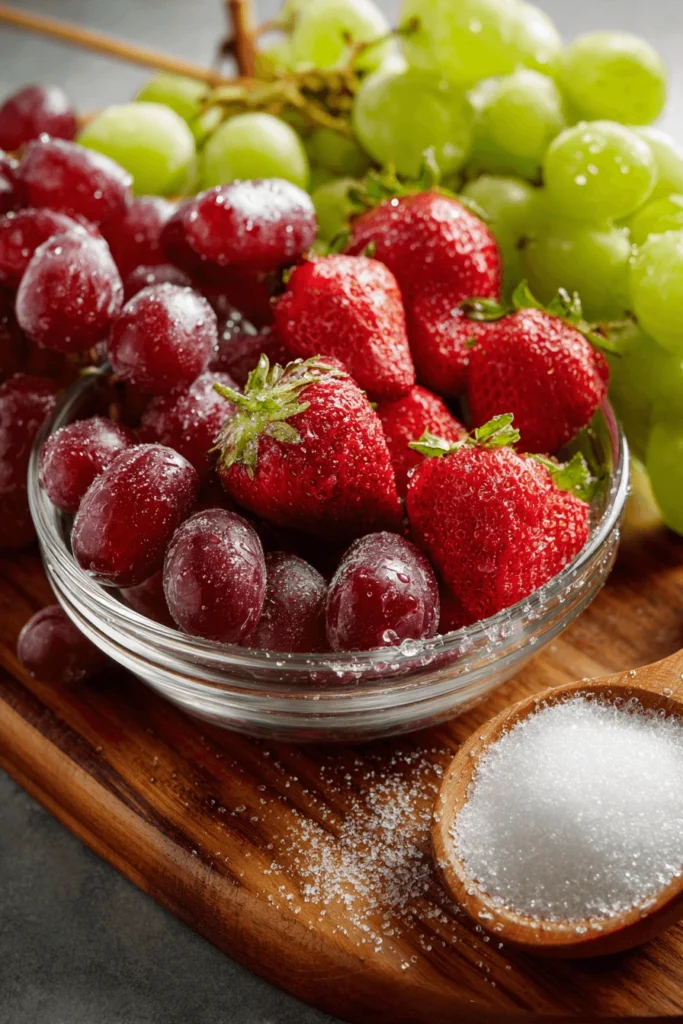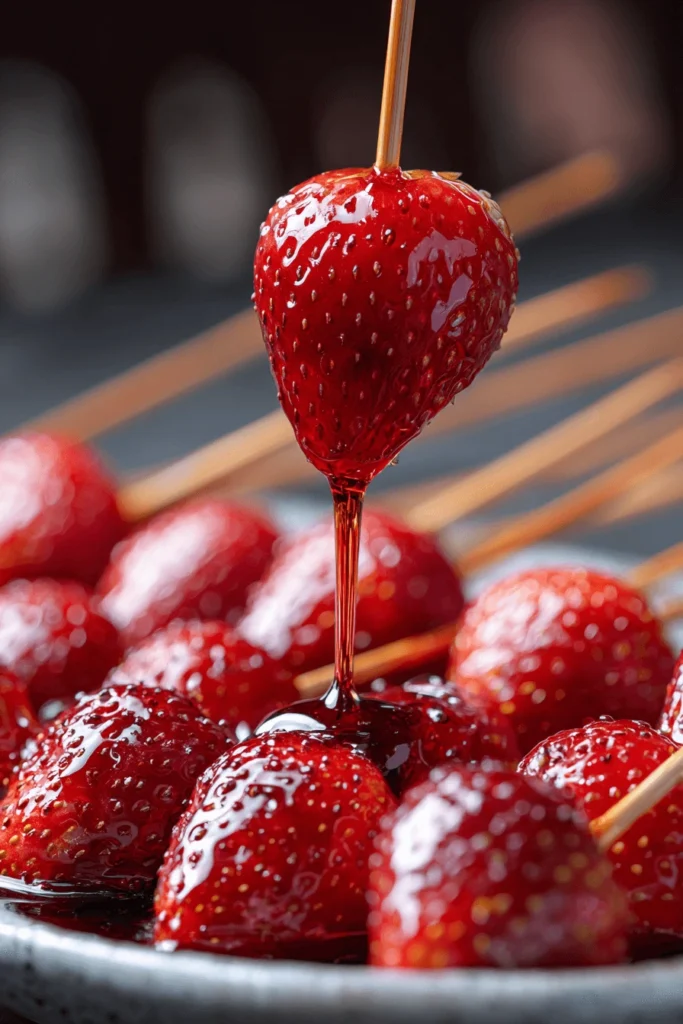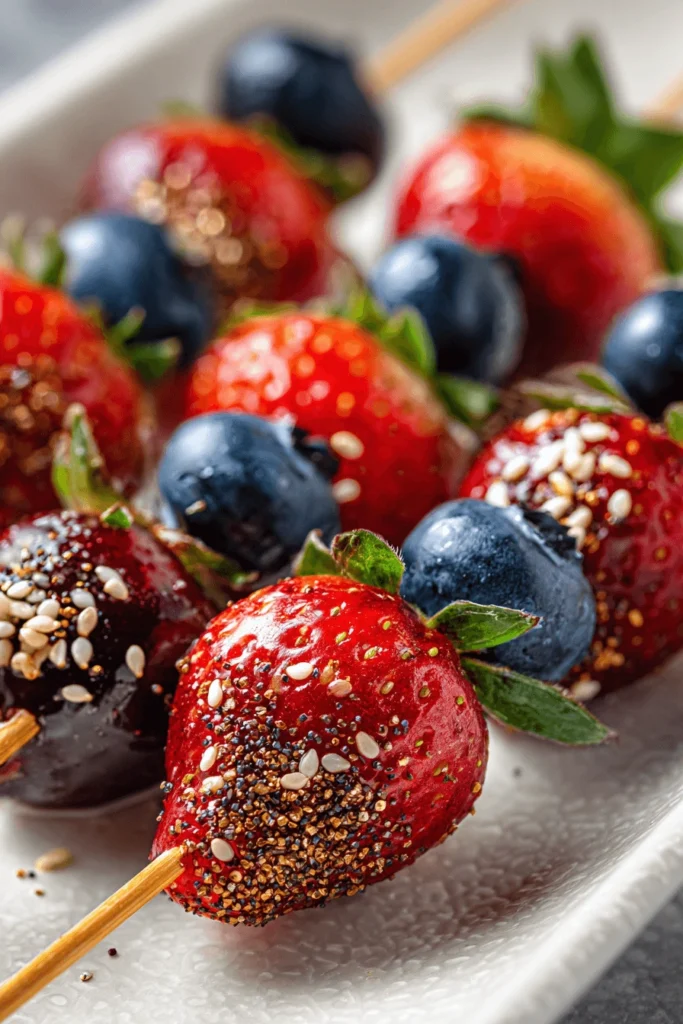If you’ve ever bitten into a piece of fruit and thought, “This would be way better in candy armor,” then you’re already halfway to discovering Tanghulu. This iconic street food—imagine juicy strawberries or grapes cloaked in a glassy sugar shell—has been crunching its way into hearts (and teeth) for centuries. In this article, we’ll explore everything from Tanghulu pronunciation to why your Tanghulu sometimes ends up sticky instead of shatteringly crisp.
Whether you’re looking for the perfect Tanghulu recipe, wondering how much water and sugar for Tanghulu you really need, or just curious about its roots in Chinese culture, this deep dive has you covered. And yes, we’ll even answer the question: is Tanghulu Korean, Chinese… or Japanese? Stick around (pun intended).
Print
Tanghulu: Crunchy Candied Fruit
- Total Time: 15 mins
Ingredients
1–2 cups strawberries or grapes
1 cup granulated sugar
½ cup water
Optional toppings: sesame seeds, shredded coconut, chopped nuts
Instructions
Wash and dry the fruit thoroughly.
Skewer the fruit with bamboo sticks.
In a saucepan, combine sugar and water; heat until 300°F (hard crack stage).
Dip fruit skewers in syrup, letting excess drip.
Place on parchment paper to cool and harden.
Sprinkle optional toppings before syrup hardens.
Notes
Keep in a dry, room-temperature location to preserve crunch.
- Prep Time: 10 mins
- Cook Time: 5 mins
Nutrition
- Serving Size: 6–12 skewers
Table of Contents
What Is Tanghulu?
Tanghulu Pronunciation and Meaning
Tanghulu (pronounced tang-hoo-loo) is a traditional street snack that hails from China, where it has been enjoyed for centuries. The word itself combines “tang,” meaning sugar, with “hulu,” which refers to a bottle gourd shape. Together, it describes fruit skewers coated in a hardened sugar syrup that shine like glass. While the Tanghulu pronunciation may sound playful, it perfectly matches the fun crunch that follows the first bite.
History and Cultural Origins in China
Tanghulu’s story begins during the Song Dynasty, over 800 years ago, when it was first made with hawthorn berries. The fruits were skewered and dipped in hot sugar syrup, then left to cool into a crunchy, glossy snack. Beyond being delicious, Tanghulu was believed to have medicinal benefits, especially for aiding digestion. Over time, Tanghulu became a symbol of Chinese street culture, sold by vendors carrying bundles of colorful skewers. Today, it’s still a nostalgic childhood favorite in China, while also turning into a global food trend.
Why Tanghulu Became Popular Worldwide
So why has Tanghulu suddenly taken over TikTok and Instagram feeds? The answer lies in its perfect mix of simplicity and satisfaction. With just two main Tanghulu ingredients—fruit and sugar—you get an eye-catching snack that’s as photogenic as it is tasty. Videos of that irresistible crack when people bite into it went viral, sparking curiosity across the world. Add in variations like Tanghulu Korean and even Japanese-inspired versions, and you’ve got a sweet that crosses cultures. The rise of DIY tutorials showing the exact Tanghulu recipe measurements and even tips on how much water and sugar for Tanghulu made it easy for anyone to try at home.
Tanghulu Ingredients and Recipe Basics
Tanghulu Ingredients You’ll Need
Making Tanghulu doesn’t require fancy tools or a trip across town. In fact, you only need a handful of simple items. The heart of every Tanghulu recipe is fruit and sugar. For fruit, you can use strawberries, grapes, blueberries, or even slices of citrus. These are commonly referred to as Tanghulu fruit, and their freshness makes all the difference. For the sugar coating, you’ll need plain granulated sugar and a touch of water. Some people add sesame seeds or a sprinkle of coconut for variety, but at its core, the recipe remains delightfully straightforward.

Tanghulu Recipe Measurements and Ratios
The secret to getting that glassy shell lies in the balance between sugar and water. Traditional Tanghulu recipe measurements call for a 2:1 ratio—about two cups of sugar to one cup of water. This simple formula ensures the syrup reaches the right temperature for hardening without burning. Some cooks add a tablespoon of corn syrup to prevent crystallization, though it’s not required. For small batches, you can easily cut this in half, but always keep the ratio consistent.
Here’s a quick reference table for clarity:
| Tanghulu Ingredients | Small Batch (6 Skewers) | Large Batch (12 Skewers) |
|---|---|---|
| Fruit (strawberries, grapes, etc.) | 1–2 cups | 3–4 cups |
| Granulated Sugar | 1 cup | 2 cups |
| Water | ½ cup | 1 cup |
How Much Water and Sugar for Tanghulu?
If you’re still wondering exactly how much water and sugar for Tanghulu, the short answer is enough to coat your fruit while keeping the syrup firm. Too much water, and the sugar won’t harden. Too little, and the mixture will burn before it reaches the proper temperature. The sweet spot is 1 cup of sugar to ½ cup of water, heated until it hits around 300°F (hard crack stage). This is the temperature where magic happens—creating that iconic “crack” when you bite into the fruit.
For a healthy twist, consider adding chia seeds to your fruit drinks, boosting nutrition while enjoying Tanghulu.
Choosing the Best Tanghulu Fruit
Classic Fruits: Hawthorn Berries, Strawberries, Grapes
The original Tanghulu was made with hawthorn berries, a tart red fruit common in northern China. While they’re not as easy to find in the U.S., you can achieve the same iconic taste and look with strawberries and grapes. Strawberries are a favorite because their juicy sweetness pairs beautifully with the brittle sugar shell. Grapes, on the other hand, offer that satisfying pop when you bite into them, making them one of the most popular Tanghulu fruit choices today.
Modern Variations: Blueberries, Oranges, and Beyond
Modern Tanghulu has gone well beyond the classics. Blueberries create bite-sized crunchy gems, while orange slices or tangerine segments deliver a sweet and tangy contrast. Some even experiment with pineapple chunks or kiwi slices for a tropical twist. The beauty of the Tanghulu recipe is that nearly any firm fruit can be transformed into a glossy candy treat. The key is making sure the fruit is fresh, firm, and thoroughly dry before dipping—any excess moisture will prevent the sugar from sticking properly.
Tips for Preparing Fruit for Tanghulu Recipe
Before skewering your fruit, give it a quick wash and pat it completely dry with a paper towel. If you skip this step, the sugar coating may slide right off, leaving you with a sticky mess. Cut larger fruits like strawberries or kiwi into halves or thick slices for even coating. Slide the fruit onto bamboo or metal skewers, leaving enough space at the bottom to hold comfortably. This not only makes dipping easier but also gives Tanghulu its signature look: shiny fruit lined up in a neat row, ready to crunch.
Step-by-Step Tanghulu Recipe Guide
Preparing Your Fruits on Skewers
Start by washing your chosen Tanghulu fruit thoroughly—whether it’s strawberries, grapes, blueberries, or orange slices. Once cleaned, it’s crucial to pat them completely dry. Any lingering moisture will cause the sugar syrup to slip off instead of sticking. Next, slide the fruit onto skewers, spacing them slightly so the sugar can coat every side evenly. For larger fruits like strawberries or kiwi slices, limit each skewer to three or four pieces to keep them stable during dipping.
Making the Perfect Sugar Syrup
Now for the magic. In a medium saucepan, combine Tanghulu ingredients: sugar and water. Stick to the golden rule of Tanghulu recipe measurements—1 cup of sugar to ½ cup of water for a small batch. Heat the mixture over medium-high heat without stirring. Stirring can encourage crystallization, so simply swirl the pan gently if needed. Use a candy thermometer if you have one, and wait until the syrup reaches about 300°F (the hard crack stage). This is when the syrup becomes crystal-clear and ready to give you that iconic crunchy shell.

Dipping and Cooling for Maximum Crunch
Once your syrup is ready, work quickly but carefully. Dip each skewer of fruit into the syrup, turning it to ensure an even coat. Let any excess drip off, then immediately place the skewers on a parchment-lined baking sheet or a lightly greased surface to cool. Within minutes, the glossy coating will harden into that classic glass-like crunch Tanghulu is known for. If you want to get fancy, you can sprinkle the freshly dipped fruit with sesame seeds, shredded coconut, or crushed nuts before the syrup hardens completely.
If you love chewy-sweet treats, our mochi ice cream recipe offers another fun dessert idea alongside Tanghulu.
Tanghulu Troubleshooting Guide
Why Is Tanghulu Not Hardening?
One of the most common frustrations when making candied fruit skewers is syrup that refuses to harden. The usual culprit is temperature. If the sugar mixture doesn’t reach the hard crack stage (around 300°F), it will stay soft and sticky instead of forming that crisp shell. Another mistake is adding too much water at the start, which delays evaporation and prevents the syrup from reaching the right consistency. The solution: use a thermometer if you can, and be patient—rushing the process often leads to undercooked syrup.
Why Is Tanghulu So Sticky?
If your fruit candy feels more like taffy than glass, humidity may be to blame. Sticky Tanghulu often happens in damp environments where the sugar coating quickly absorbs moisture from the air. Another reason could be that the syrup was left on the fruit too long before cooling, giving it time to soften. To avoid this, make sure your kitchen is dry, place the dipped skewers on parchment paper immediately, and let them cool fully before serving.
How Long Does Tanghulu Take to Harden?
Typically, once dipped, the sugar shell begins to harden within 2 to 3 minutes. You’ll know it’s ready when the coating looks glossy and you hear that satisfying crack when tapped. If yours is taking longer, check whether the syrup was at the right temperature or if your fruit was completely dry before dipping. Any extra juice or water left on the fruit can interfere with the hardening process, leaving you with a softer finish than expected.
Tanghulu Around the World
Tanghulu Korean vs Tanghulu Chinese
Although Tanghulu is undeniably Chinese in origin, its popularity in Korea has given rise to its own identity there. Street vendors in Seoul often sell candied strawberries and grapes under the same name, and the treat has become especially trendy among younger generations. The difference lies more in presentation than in recipe—Tanghulu Korean versions are often packaged more neatly, with smaller skewers and fruit arranged for aesthetic appeal. In China, meanwhile, traditional hawthorn berries remain a staple, and vendors often display dozens of skewers bundled together, creating a colorful spectacle.
Is Tanghulu From Japan? Clearing Up Confusion
Some people mistakenly believe Tanghulu is Japanese because candied fruit also appears in Japanese street festivals. While Japan has its own versions of sweet fruit snacks, Tanghulu is not one of them. The confusion often arises because Japanese candied apples (ringo ame) look somewhat similar. However, the origins of Tanghulu remain firmly Chinese, with hawthorn berries as its authentic base. So while you may find something that looks like Tanghulu at a Japanese fair, it’s technically a different tradition.
How Social Media Made Tanghulu a Viral Snack
If Tanghulu has been around for centuries, why is it suddenly everywhere now? The answer is simple: social media. Platforms like TikTok and Instagram turned the satisfying crack of biting into candied fruit into a viral soundbite. The glossy sugar coating photographs beautifully, making it an instant hit for food bloggers and vloggers alike. Tutorials showing easy ways to master the Tanghulu recipe at home only added to the craze. From Seoul to San Francisco, Tanghulu has transformed from a nostalgic street snack to a global sensation.
Tanghulu Recipe Variations and Fun Twists

Adding Sesame Seeds, Nuts, or Coconut
Once you’ve mastered the classic sugar-coated fruit, it’s time to get creative. Sprinkling sesame seeds over freshly dipped fruit adds a nutty flavor and a crunchy texture. Chopped nuts like almonds or pistachios also work beautifully. For a tropical flair, try a light dusting of shredded coconut. These variations not only enhance flavor but also make your Tanghulu recipe visually stunning, perfect for parties or social media photos.
Using Different Sugars for Unique Flavors
While traditional Tanghulu uses granulated sugar, experimenting with other types of sugar can bring exciting flavor twists. Brown sugar gives a caramel-like richness, while raw cane sugar adds a deeper, more rustic flavor. Some adventurous cooks even mix in a bit of honey or maple syrup to the sugar-water mixture for a subtle twist. Just keep an eye on the syrup’s temperature, as alternative sugars may caramelize faster or slower than granulated sugar.
Mini Tanghulu and Party Skewers
Want to impress guests at a party? Try making mini Tanghulu. Use small fruits like blueberries or halved grapes on tiny skewers for bite-sized treats. Not only are they easier to eat, but they also make a colorful, festive platter. You can even create themed fruit combinations, like red and green berries for Christmas or tropical colors for summer events. Mini Tanghulu makes the candy visually appealing while keeping the classic crunch intact.
Looking for more sweet mini desserts? Discover our mini Tres Leches cake recipes for party-ready treats that pair perfectly with Tanghulu.
Serving, Storing, and Enjoying Tanghulu
How to Store Tanghulu Without Losing Crunch
Tanghulu is best enjoyed fresh, but if you need to store it, a few simple tips will help maintain that iconic crunch. Keep the skewers in an airtight container at room temperature—avoid the fridge, as humidity can make the sugar coating sticky. Layer parchment paper between skewers to prevent them from sticking together. Properly stored, Tanghulu can stay crisp for up to 24 hours, making it perfect for preparing ahead for parties or events.
Best Pairings with Drinks or Snacks (Non-Alcoholic)
While the sugar coating makes Tanghulu a treat on its own, pairing it with complementary drinks can elevate the experience. Consider sparkling apple cider, fruit spritzers, or iced herbal teas flavored with lemon, mint, or berries. These refreshing beverages balance the sweetness of the candied fruit and make Tanghulu a fun snack for kids and adults alike. Avoid high-humidity drinks that can soften the candy shell.
Serving Tanghulu for Parties and Celebrations
Tanghulu’s visual appeal makes it a standout at any gathering. Arrange skewers in a colorful display or stand them upright in a vase filled with decorative beads or sugar crystals. Mini Tanghulu skewers are especially crowd-pleasing for kids’ parties or festive occasions. For a twist, mix fruits with different colors on a single skewer—red strawberries, green grapes, and orange segments make an eye-catching centerpiece. Serving Tanghulu this way turns a simple snack into a conversation starter and keeps everyone coming back for more.
Health, Nutrition, and Tanghulu’s Sweet Balance
Calories and Sugar in Tanghulu Recipe
While Tanghulu is undeniably delicious, it’s important to be mindful of its sugar content. Each skewer, depending on the fruit and sugar coating, can contain anywhere from 80 to 150 calories. The sugar shell is mostly pure sucrose, which provides quick energy but little nutritional value. That said, the fresh fruit inside adds vitamins, fiber, and antioxidants, giving your treat a small nutritional boost. Moderation is key—Tanghulu is perfect as an occasional indulgence or festive snack.
Can Tanghulu Fit into a Healthy Lifestyle?
Absolutely! You can make Tanghulu part of a balanced diet by focusing on portion control and fruit selection. Using smaller skewers with berries or grapes ensures you enjoy the sweet crunch without overdoing sugar. For a slightly lighter version, reduce the sugar slightly or experiment with alternative sweeteners, though achieving the perfect hard shell may take some practice. The key is to enjoy Tanghulu mindfully, as a fun and visually appealing treat rather than a daily snack.
Tips for Making Tanghulu a Smarter Treat
- Opt for fruits that are naturally high in water content but firm, like grapes or blueberries, to balance sweetness.
- Serve Tanghulu alongside fresh fruit platters or yogurt for added fiber and protein.
- Make smaller, bite-sized skewers to keep portion sizes reasonable.
- Store in a dry environment to maintain the sugar shell without adding extra sticky sugar layers.
By following these simple guidelines, you can enjoy Tanghulu guilt-free while still savoring the traditional crunchy, sweet delight that makes it so irresistible.
FAQs About Tanghulu
Is Tanghulu Korean or Chinese?
Tanghulu is originally Chinese, dating back to the Song Dynasty. While it’s also popular in Korea today and often called Tanghulu Korean, the traditional version with hawthorn berries and sugar syrup originates in China. Korean versions typically use strawberries or grapes, but the method remains largely the same.
What exactly is Tanghulu made of?
At its simplest, Tanghulu is made of fresh Tanghulu fruit like strawberries, grapes, or hawthorn berries, coated in a hardened sugar syrup. The syrup is prepared by heating sugar and water to the hard crack stage, then dipping the skewered fruit for a glossy, crunchy finish. Optional toppings include sesame seeds, shredded coconut, or chopped nuts.
Is Tanghulu from Japan?
No, Tanghulu is not from Japan. While Japan has its own candied fruit traditions, the original Tanghulu is distinctly Chinese. Confusion often comes from Japanese candied apples (ringo ame), which visually resemble Tanghulu but are a separate cultural snack.
Why is Tanghulu not hardening?
If your Tanghulu isn’t forming a crunchy shell, it’s usually because the sugar syrup didn’t reach the proper temperature (around 300°F) or there was too much moisture on the fruit. Ensuring completely dry fruit and using a candy thermometer can help achieve the classic hard crack finish.
How long does Tanghulu take to harden?
Typically, Tanghulu hardens within 2–3 minutes after dipping. You’ll know it’s ready when the coating looks glassy and snaps easily when tapped. Temperature and fruit moisture are key factors affecting hardening time.
Why is Tanghulu so sticky?
Sticky Tanghulu usually results from humidity or syrup that hasn’t fully cooled. Any moisture in the environment or on the fruit can prevent the sugar shell from hardening properly. Always dip in a dry kitchen and let skewers cool on parchment paper to achieve a crisp texture.
Conclusion
Tanghulu is more than just a sweet snack; it’s a crunchy, sugar-coated celebration of fruit that has captivated taste buds for centuries. From its origins in China to its trendy appearances in Korea and on social media worldwide, Tanghulu proves that simple ingredients—fruit and sugar—can create something extraordinary.
Find more delicious recipes on DifferentyRecipes Pinterest, and stay inspired with the newest tips and ideas by following DifferentyRecipes on Facebook.
